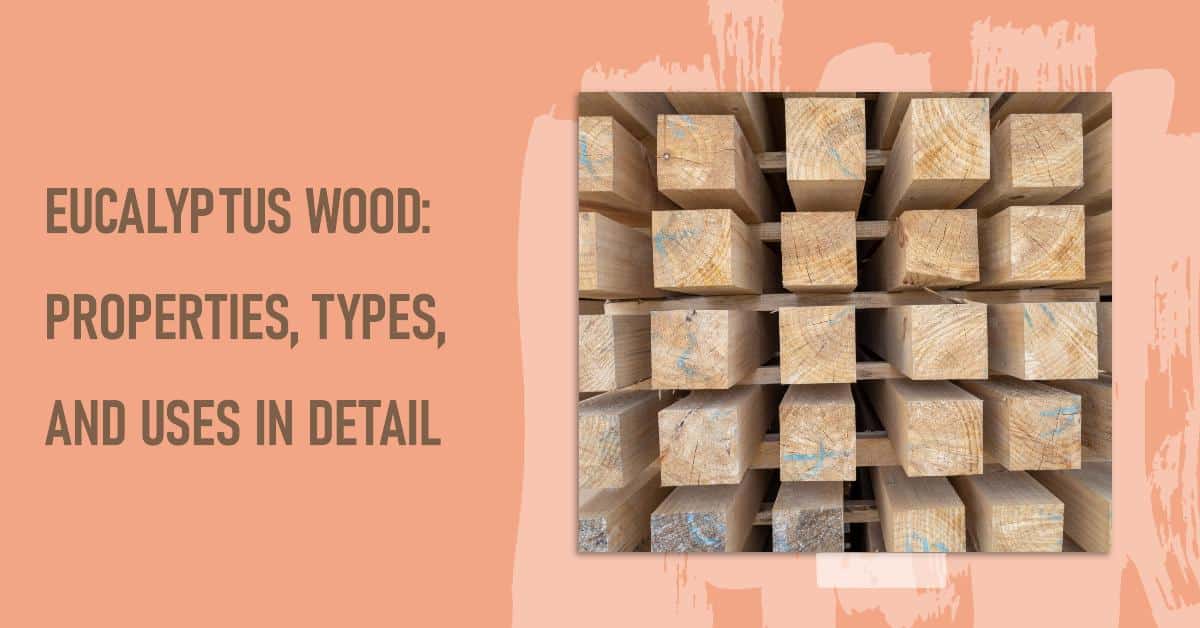Eucalyptus wood, originating from the extensive genus Eucalyptus within the Myrtaceae family and is native to Australia, has garnered global recognition for its diverse applications and unique properties. Its various species offer unique characteristics that cater to different needs, from robust construction materials to aesthetically pleasing furniture and efficient fuel sources. Its rapid growth and renewable nature position it as an eco-friendly alternative to traditional hardwoods, while its physical properties ensure longevity and resilience.
This article delves into the distinctive properties of Eucalyptus wood, the various types available, and its main uses in different industries.
Eucalyptus Wood Properties

Density and Hardness
This wood is known for its high density, which contributes to its durability and strength. Depending on the species, the density ranges from 500 kg/m³ to over 900 kg/m³. The Janka hardness rating varies but generally falls between 1,200 to 2,200 lbf, making it harder than many traditional hardwoods like oak and maple.
Color and Grain
The heartwood ranges from light pink to reddish-brown, while the sapwood is typically pale yellow. Over time, the wood darkens with exposure to light and air. The grain pattern is generally straight, although it can be interlocked or wavy in some species. This grain structure contributes to its attractive appearance.
Workability
It is generally easy to work with, both by hand and with power tools, though its unstable moisture content necessitates careful processing, drying, and finishing before use. It tends to shrink and warp easily, requiring controlled kiln or air drying to maintain dimensional stability. Furthermore, careful storage and packing during transportation are essential to preserve the wood’s quality and prevent any damage.
Technical Properties
| Property | Value |
|---|---|
| Specific Gravity | Basic: 0.60, 12% MC: 0.85 |
| Janka Hardness | 1,420 lbf (6,330 N) |
| Modulus of Rupture | 17,110 lbf/in² (118.0 MPa) |
| Elastic Modulus | 2,049,000 lbf/in² (14.13 GPa) |
| Crushing Strength | 8,640 lbf/in² (59.6 MPa) |
| Shrinkage | Radial: 8.2%, Tangential: 12.8%, Volumetric: 21.0%, T/R Ratio: 1.6 |
Types of Eucalyptus Wood
There are over 700 species of Eucalyptus tree, but a few are commonly used in the timber industry:
- Eucalyptus Globulus (Blue Gum): This species is renowned for its strength and durability. It is frequently used in construction, flooring, and furniture making.
- Eucalyptus Marginata (Jarrah): Jarrah wood is known for its rich red color and high resistance to weathering and insect attacks. It is commonly used in outdoor furniture, decking, and heavy construction.
- Eucalyptus Camaldulensis (River Red Gum): River Red Gum wood is valued for its beautiful appearance and durability. It is often used in fine furniture, flooring, and veneers.
- Eucalyptus Grandis (Rose Gum): Rose Gumwood is lighter in color and easier to work with than other species. Useful in joinery, cabinetry, and general carpentry.
- Eucalyptus Regnans (Mountain Ash): This species is one of the tallest trees in the world and provides a pale, straight-grained wood ideal for furniture, flooring, and paper production.
Uses of Eucalyptus Wood
- Construction and Building: Due to its strength and durability, its usage is often found in structural applications, including beams, posts, and flooring. Its resistance to wear makes it suitable for high-traffic areas.
- Furniture Making: The aesthetic appeal of Eucalyptus wood, with its rich colors and unique grain patterns, makes it a popular choice for furniture.
- Flooring: Its extreme hardness and durability make it an excellent choice for flooring. It can withstand heavy use and maintains its appearance over time.
- Decking and Outdoor Use: Species like Jarrah and Blue Gum suit exterior applications. Their natural resistance to the elements makes them ideal for decking, fencing, and garden furniture.
- Paper and Pulp: The paper industry extensively utilizes certain Eucalyptus species. These trees produce high-quality pulp from their wood fibers, which manufacturers use for manufacturing various types of paper products.
- Fuel and Charcoal: It has a high calorific value, making it an efficient source of firewood and charcoal. It burns hot and clean, which benefits domestic and industrial fuel applications.
- Medicinal and Aromatic Uses: Beyond timber, Eucalyptus leaves are drawn from its trees, which produce essential oils with medicinal properties. Eucalyptus oil is widely used in pharmaceuticals, cosmetics, and aromatherapy.
How Much Does Eucalyptus Wood Cost?
The cost of Eucalyptus lumber varies based on factors such as the specific species, quality, processing methods, and regional availability. Generally, it is moderately priced compared to other hardwood options, making it an attractive option for both commercial and residential wood projects.
The affordability, with its strength and aesthetic appeal, makes it a cost-effective choice for flooring, furniture, and construction. However, costs can rise with the need for careful drying and handling to prevent warping and shrinkage. Additionally, sustainably sourced Eucalyptus timber may command higher prices due to the certification and eco-friendly practices involved in its production.

